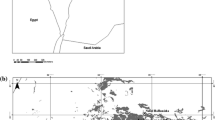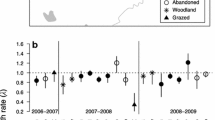Abstract
Pulsatilla patens (L.) Mill. (Ranunculaceae) is a threatened plant which in Fennoscandia favours south-facing, warm slopes of pine-dominated esker forests. The cessation of cattle grazing, modern forestry practices, and especially efficient fire prevention have resulted in closure of undergrowth vegetation in these forests. Using generalized linear models (GLM), we studied the relationships between habitat factors (covers of field and ground layer and amount of litter) and the population structure of P. patens in 48 populations in Finland in order to identify favourable conditions for regeneration. The largest populations occurred at sites with intermediate values of both ground and field layer. The number of juvenile plants was also highest at intermediate values of ground layer. Dense moss layer and abundant litter had a negative effect on the flowering of P. patens. In conclusion, creation and maintenance of habitat heterogeneity to prevent the closure of undergrowth vegetation is of paramount importance for the successful reproduction of P. patens.
Similar content being viewed by others
References
Alalammi P. (1987). Atlas of FinlandFolio 131, Climate. National Board of Survey and Geographical Society of Finland, Helsinki
Austin M.P., Nicholls A.O. and Margules C.R. (1990). Measurement of the realized qualitative niche: environmental niches of five Eucalyptus species. Ecological Monographs 60(2): 161–177
Bergstedt J. and Milberg P. (2001). The impact of logging intensity on field-layer vegetation in Swedish boreal forests. Forest Ecology and Management 154: 105–115
Brook B.W., O'Grady J.J., Chapman A.P., Burgman M.A., Akçakaya H.R. and Frankham R. (2000). Predictive accuracy of population viability analysis in conservation biology. Nature 404: 385–387
Brzosko E. (2002). Dynamics of island populations of Cypripedium calceolus in the Biebrza river valley (north–east Poland). Botanical Journal of the Linnaean Society 139: 67–77
Council of Europe. 1979. Convention on the conservation of European wildlife and natural habitats. Bern, Switzerland (http://www.coe.int/T/E/Cultural_Co-operation/Environment/Nature_ and_ biological_diversity/Nature_protection/)
Crawley M.J. (1993). Glim for Ecologists. Blackwell Scientific Publications, Oxford etc
Dudash M.R. and Fenster C.B. (2000). Inbreeding and outbreeding depression in fragmented populations. In: Young, A.G. and Clarke, G.M. (eds) Genetics, Demography and Viability of Fragmented Populations, pp 35–53. Cambridge University Press, Cambridge
Dzwonko Z. and Gawroński S. (2002). Influence of litter and weather on seedling recruitment in a mixed oak-pine woodland. Annals of Botany 90: 245–251
Ellstrand N.C. and Elam D.R. (1993). Population genetic consequences of small population size: Implications for plant conservation. Annual review of Ecology and Systematics 24: 217–242
Eriksson O. (1995). Seedling recruitment in deciduous forest herbs: the effects of littersoil chemistry and seedbank. Flora 190: 65–70
Esseen P.-A., Ehnström B., Ericson L. and Sjöberg K. (1992). Boreal forests – the focal habitats of Fennoscandia. In: Hansson, L. (eds) Ecological Priciples of Nature Conservation, pp 252–325. Elsevier Applied Science, London and New York
Facelli J.M. and Pickett S.T.A. (1991). Plant litter: its dynamics and effects on plant community structure. Botanical Review 57: 1–32
Finnish Meteorological Institute (2000). Climatological data 1999. Meteorological Yearbook of Finland 1999: 1–78
Fischer M. and Matthies D. (1998). Experimental demography of the rare Gentianella germanica: seed bank formation and microsite effects on seedling establishment. Ecography 21: 269–278
Gärdenfors U. (2000). Rödlistade arter i Sverige 2000 – The 2000 Red List of Swedish species. ArtDatabanken, SLU, Uppsala
Groom M.J. and Pascual M.A. (1998). The analysis of population persistence: an outlook on the practice of viability analysis. In: Fiedler, P.G. and Kareiva, P.M. (eds) Conservation Biology for the Coming Decade, pp 4–27. Chapman and Hall, New York
Grubb P.J. (1977). The maintenance of species-richness in plant communities: the importance of the regeneration niche. Biological Reviews 52: 107–145
Hegland J.S., van Leeuwen M. and Oostermeijer J.G.B. (2001). Population structure of Salvia pratensis in relation to vegetation and management of Dutch dry floodplain grasslands. Journal of Applied Ecology 38: 1277–1289
Holub J. and Procházka F. (2000). Red List of vascular plants of the Czech Republic – 2000. Preslia, Praha 72: 187–230
Hultén E. and Fries M. (1986). Atlas of the North European Vascular Plants North of the Tropic of Cancer. III Commentary to the Maps. Koelz Scientific Books, Königstein, 969–1172
Jalas J. (1950). Zur Kausalanalyse der Verbreitung einiger nordischen Os- und Sandpflanzen. Annales Botanici Societatis Zoologicae Botanicae Fennicae “Vanamo” 24: 1–362
Jensen K. and Meyer C. (2001). Effects of light competition and litter on performance of Viola palustris and on species composition and diversity of an abandoned fen meadow. Plant Ecology 155: 169–181
Jonsson O., Rosquist G. and Widén B. (1991). Operation of dichogamy and herkogamy in five taxa of Pulsatilla. Holarctic Ecology 14: 260–271
Kalliovirta M., Kukk Ü . and Ryttäri T. 2003. Pulsatilla patens (L.) Mill. In: Ryttäri T., Kukk Ü ., Kull T., Jäkäläniemi A. and Reitalu M. (eds), Monitoring of Threatened Vascular Plants in Estonia and Finland – Methods and Experiences, pp. 37–47. Finnish Environment 659: 1–122.
Kuuluvainen T. (1994). Gap disturbanceground microtopography and the regeneration dynamics of boreal coniferous forests in Finland: a review. Annales Zoologici Fennici 31: 35–51
Lilleleht V. 1998. Eesti punane raamat. Ohustatud seenedtaimed ja loonad. Eesti Teaduste Akadeemia Looduskaitse Komisjon, Tartu (in Estonian).
Ludwig D. (1999). Is it meaningful to estimate a probability of extinction?. Ecology 80: 298–310
Ludwig G. and Schnittler M. (1996). Rote Liste gefährdeter Pflanzen Deutschlands`. Schriftenreihe für VegetationskundeVol. 28. Bundesamt für Naturschutz, Bonn-Bad Godesberg, 1–744
Menges E.S. (2000). Population viability analyses in plants: challenges and opportunities. Trends in Ecology and Evolution 15: 51–56
Menges E.S. and Dolan R.W. (1998). Demographic viability of populations of Silene regia in midwestern prairies: relationships with fire management, genetic variation, geographic location, population size and isolation. Journal of Ecology 86: 63–78
Morris W., Doak D., Groom M., Kareiva P., Fieberg J., Gerber L., Murphy P. and Thomson D. (1999). A practical handbook for population viability analysis. The Nature Conservancy, Washington, DC
Myster R.W. (1994). Contrasting litter effects on old field tree germination and emergence. Vegetatio 114: 169–174
Overbeck G., Kiehl K. and Abs C. (2003). Seedling recruitment of Succisella inflexa in fen meadows: Importance of seed and microsite availability. Applied Vegetation Science 6: 97–104
Peterson C.J. and Facelli J.M. (1992). Contrasting germination and seedling growth of Betula alleghaniensis and Rhus typhina subjected to various amounts and types of plant litter. American Journal of Botany 79: 1209–1216
Pilt I. and Kukk Ü. (2002). Pulsatilla patens and Pulsatilla pratensis (Ranunculaceae) in Estonia: distribution and ecology. Proceedings of the Estonian Academy of Sciences, Biology Ecology 51: 242–256
Oostermeijer J.G.B., Luijten S.H., Křenová Z.V. and den Nijs H.C.M. (1998). Relationships between population and habitat characteristics and reproduction of the rare Gentiana pneumonanthe L. Conservation Biology 12: 1042–1053
Oostermeijer J.G.B., Luijten S.H. and den Nijs J.C.M. (2003). Integrating demographic and genetic approaches in plant conservation. Biological Conservation 113: 389–398
Payne C.D. 1986. The GLIM System Release 3.77. Manual. Numerical Algorithms Group, Royal Statistical Society.
Peñuelas J., Filella I., Zhang X., Llorens L., Ogaya R., Lloret F., Comas P., Estiarte M. and Terradas J. (2004). Complex spatiotemporal phenological shifts as a response to rainfall changes. New Phytologist 161: 837–846
Pykälä J. (2004). Immediate increase in plant species richness after clear-cutting of boreal herb-rich forests. Applied Vegetation Science 7: 29–34
Rassi P., Alanen A., Kanerva T. and Mannerkoski I. (2001). The 2000 Red List of Finnish species. The II Committee for the Monitoring of Threatened Species in Finlandthe Ministry of the Environment, Helsinki
Ryttäri T., Kukk Ü., Kull T., Jäkäläniemi A. and Reitalu M. (eds) 2003. Monitoring of Threatened Vascular Plants in Estonia and Finland – Methods and Experiences. Finnish Environment 659: 1–122.
Saavedra F., Inouye D.W., Price M.V. and Harte J. (2003). Changes in flowering and abundance of Dephinium nuttallianum (Ranunculaceae) in response to a subalpine climate warming experiment. Global Change Biology 9: 885–894
Stoutjesdijk Ph. and Barkman J.J. (1992). MicroclimateVegetation and Fauna. Opulus Press AB, Knivsta
Sydes C. and Grime J.P. (1981a). Effects of tree leaf litter on herbaceous vegetation in deciduous woodland. I. Field investigations. Journal of Ecology 69: 237–248
Sydes C. and Grime J.P. (1981b). Effects of tree leaf litter on herbaceous vegetation in deciduous woodland. II. An experimental investigation. Journal of Ecology 69: 249–262
Tilman D. (1993). Species richness of experimental productivity gradients: how important is colonization limitation?. Ecology 74(8): 2179–2191
Thompson K., Bakker J. and Bekker R. 1997. The Soil Seed Banks of North West Europe: Methodology, Density and Longevity. Cambridge University Press, pp.276.
Uotila P. (1969). Ecology and area of Pulsatilla patens (L.) Mill. in Finland. Annales Botanici Fennici 6: 105–111
Uotila P. (1996). Decline of Anemone patens (Ranunculaceae) in Finland. Symbolae Botanicae Upsalienses 31(3): 205–210
Vanha-Majamaa I. and Lähde E. (1991). Vegetation changes in a burned area planted by Pinus sylvestris in Northern Finland. Annales Botanici Fennici 28: 161–170
Vergeer P., Rengelink R., Copal A. and Ouborg N.J. (2003). The interacting effects of genetic variation, habitat quality and population size on performance of Succisa pratensis. Journal of Ecology 91: 18–26
Wells T.C.E. and Barling D.M. (1971). Biological flora of the British Isles. Pulsatilla vulgaris Mill. Anemone pulsatilla J. Ecol. 59: 275–292
Wildeman A.G. and Steeves T.A. (1982). The morphology and growth cycle of Anemone patens. Canadian Journal of Botany 60: 1126–1137
Author information
Authors and Affiliations
Corresponding author
Rights and permissions
About this article
Cite this article
Kalliovirta, M., Ryttäri, T. & Heikkinen, R.K. Population structure of a threatened plant, Pulsatilla patens, in boreal forests: modelling relationships to overgrowth and site closure. Biodivers Conserv 15, 3095–3108 (2006). https://doi.org/10.1007/s10531-005-5403-z
Received:
Accepted:
Published:
Issue Date:
DOI: https://doi.org/10.1007/s10531-005-5403-z




